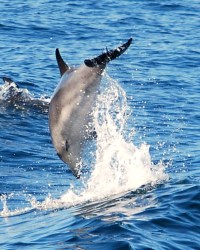(949) 675-0551 |
| DESCRIPTION: One of the most recognizable and often seen kinds of dolphins. Bottlenose dolphins have a short round beak hence the name “bottlenose” and are typically a grey color on top and pinkish white on their bellies. This is the most common used dolphin in marine parks and movies or TV shows such as “Flipper”. This is mainly due to their size, intelligence, and more flexibility than other dolphin species. Bottlenose dolphins are much larger than you would think reaching a length of 8-12 feet and some being well over 1,000 lbs. The males are much larger than the females in this species. They are also identified by having a very high and curved dorsal fin. | |
| RANGE/HABITAT: Found worldwide in temperate and tropical areas. Bottlenose dolphins are commonly seen near lagoons, bays, estuaries, and river mouths. There are two populations of bottlenose in southern California, an inshore and offshore population. The inshore population seems to be smaller than the offshore population. There is not any major difference between the two populations other than that the inshore dolphins seem to be smaller than the offshore dolphins. Bottlenose dolphins live in small groups called a pod, and some pods can have a limited home range that they stay in and others are migratory. | |
| BEHAVIOR: Bottlenose dolphins will feed mainly on fish but will also eat squid, octopus, and crustaceans. Most bottlenose will hunt independently but occasionally will work together in a group to capture fish in a bait ball. Bottlenose are also one of the only dolphins that will use strategic tactics to trap fish in shallow water mud flats and use high speeds to hydroplane in over the shallow water to catch the fish. They will also exhibit many acrobatic behaviors often jumping high out of the water to signal to other dolphins of their location or a where food is found. Bottlenose have also been known to play with their food, and toss a fish into the air with their tail or play with fish, jellyfish, or other marine animals seemingly just for fun. A bottlenose dolphin has 18-26 pairs of cone shaped teeth used for grabbing its food and swallowing it whole, so they do not share their food with other dolphins and catch their own meals. | |
 |
MATING / BREEDING: Male bottlenose dolphins mature at about 10 years old while females mature between 5-10 years. They have a gestation period of one year and calving peaks in the spring and fall. The babies are born able to swim and nurse their mother’s milk for several months until they are weaned and taught to catch live food. The babies will stay with their mother learning all they need for survival for 3-6 years and if the mothers have another baby during this time, aunts, grandmas and other females in the pod will care for the older calf as babysitters. |
| STATUS: Bottlenose dolphins are protected by the Marine Mammal Protection Act of 1972 and are in plentiful numbers in most places around the world. There are still areas where dolphins are being exploited and there numbers are being depleted, the worst being in the Black Sea. Bottlenose dolphins also inspired the dolphin free tuna movement because of the accidental catching of dolphins in purse seines and gillnets. Tuna fishing has sense improved in the tactics they use to catch tuna to help protect dolphins but bycatch still occurs around the world. Coastal pollution is also a threat to bottlenose dolphins and can affect their health and populations especially for inshore dolphins. There are also viruses and toxin related diseases that affect dolphin populations, one in southern California being domoic acid poisoning. Domoic acid is a toxin naturally produced during the reproduction of a species of plankton found in coastal environments. When this plankton is ingested by small fish the toxin magnifies and eventually has a potentially lethal affect on top predators like dolphins, seals and sea lions, and pelicans. The plankton blooms that cause this disease are naturally occurring but are increasing in unnatural periods and occurring more often. This increase in occurrence is thought to be linked to fertilizer and nutrient run off from agricultural lands into coastal oceans. | |
For Reservations Call: |
||
(949) 675-0551 |
||
Newport Beach Whale Watching 309 Palm St. #A - Newport Beach CA. 92661 |
||
Copyright © 2001 Newport Landing
Whale Watching |
Whale Watching | Whale Watching Dana Point Visitors | Whale Watching Long Beach Visitors | Whale Watching Los Angeles Visitors
Whale Watching San Diego Visitors | Huntington Beach Whale Watching | Whale Watching Laguna Beach | Catalina Island Whale Watching